Reviving Our Oyster Reefs: A Success Story
In 2023, Florida Oceanographic Society's research team launched the Oyster Gardening Pilot Program, an initiative aimed at restoring local oyster reefs. In collaboration with local volunteers, this program played a pivotal role in nurturing wild-caught oyster spat, contributing to the return of over 1,000 adult oysters to their natural habitat. This success not only replenished vital ecosystems but also laid the foundation for future research and restoration practices.
The significance of oyster reefs in maintaining the health of the Indian River Lagoon (IRL) and St. Lucie Estuary (SLE) cannot be overstated. Oysters (Crassostrea virginica) act as natural filters, purifying water while providing crucial habitats for fish, crabs, birds, and other filter feeders. Additionally, these reefs serve as a protective barrier against storm surge and erosion. However, the adverse impacts of urbanization and freshwater discharges have led to a significant decline in IRL and SLE oyster reefs since the 1940s (Wilson et al. 2005; Lapointe et al. 2015).
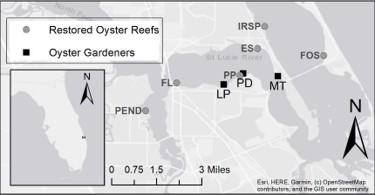
Figure 1. Map of locally restored oyster reefs and oyster gardens. Wild spat were collected and then returned as adults to restored reefs (circles)(PEND, FL, PP, ES, FOS, IRSP, DW), after being gardened at volunteer docks (squares)(LP,MT,PD).
Oyster Gardening
Wild oyster spat were collected with PVC T’s from seven locally restored reefs in the SLE and Southern IRL (Fig. 1) between February 2022 and 2023. Oyster shells, collected from local restaurants through the Florida Oceanographic Society FL.O.O.R. program, were strung in pairs of seven on a PVC T-bar (Fig. 2), then deployed at each site. Wild oyster spat were collected monthly and stored in flow-through tanks at Florida Oceanographic Society until deployment in February 2023.
Prior to oyster garden deployment, all live spat on shell were counted and shell height (hinge to bill) was measured. At deployment, oyster cages were hung from docks so they remained fully submerged, independent of tides. Across the 9 oyster cages, 268 spat-on shell were deployed, averaging 89 ± 1.5 per gardener and 11.0 ± 7.55 mm shell height.
Once deployed, volunteers provided weekly cage maintenance and care for the oyster gardens for 8 months. This included freshwater rinsing, and 2 – 3 hours out of water shading, to allow cages to dry for removal of algae, barnacles, and other organisms which may have limited the flow of water through cages. Gardens were monitored by Florida Oceanographic Society research staff after 4 months, and collected after 8 months.
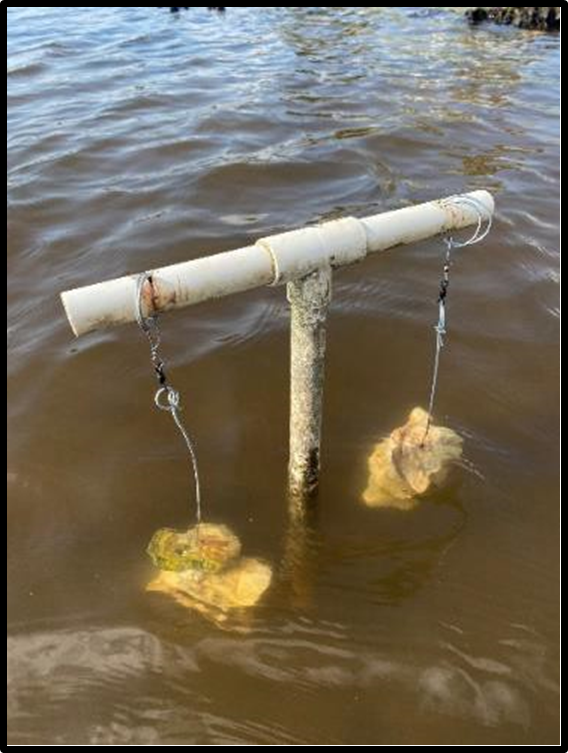
Figure 2. PVC T-bar used to collect oyster spat that allows the shells to hang, suspended in the water column.
Results
There was a gradual increase in oyster shell height over the course of the project for all gardens and origins combined (Fig. 3A). This gradual increase indicates that oysters are maturing and becoming stable adults within the cages. Additionally, at oyster gardening deployment (Pre), the number of oyster spat across gardens averaged 12.8 ± 9.0 oysters, which increased significantly to 114.2 ± 100.7 oysters at the final collection (Post)(Fig. 3B). This suggests that oysters naturally recruited to the gardens.
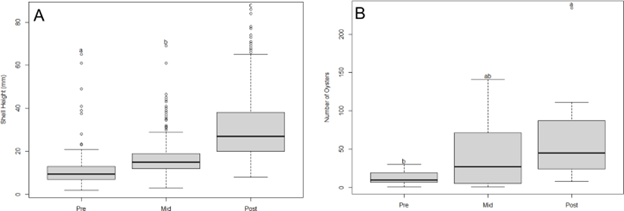
Figure 3. Box and whisker plots for: (A) spat on oyster shell height (mm) and (B) number of oysters from pre-deployment in February 2023 (Pre), mid-way check-in in May 2023 (Mid), and final collection in September 2023. (Post). These plots provide a clear visual summary of the range, median, and quartiles. Oyster growth and abundance increased gradually from pre-deployment to final collection.
The wild-caught oyster spat, now stable adults, along with newly settled recruits, were placed by hand on the original restored reef from which they came (Table 1). Care was given to secure oysters within the oyster reef by carefully positioning them to ensure they were lodged and firmly pressed into the reef.
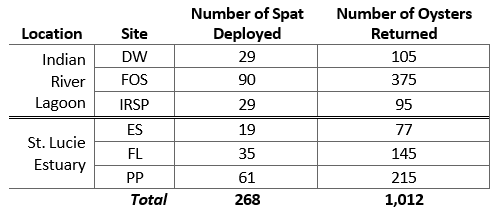
Table 1. Number of spat deployed in oyster gardens and adult oysters returned to the original restoration reefs where wild spat was collected following oyster gardening deployment from February to September 2023.
Conclusion
Due to increased oyster growth and recruitment, the oyster gardening pilot program using wild-caught spat from seven locally restored oyster reefs was successful. Three dedicated oyster gardening volunteers returned 1,012 adult oysters (Table 1) to our IRL and SLE oyster reefs. Based on the Florida Oceanographic Society’s monthly oyster spat monitoring, it is also surprising to see this much spat recruitment to the gardens since the monthly spat monitoring remained close to zero for all of 2023. This high recruitment may be due to oyster gardeners' cage cleaning and protection efforts. Previous oyster gardening projects in Delaware have also had great recruitment success by reintroducing healthy adult oysters to our waters for natural growth (Rossi-Snook et al. 2009).
The oyster gardening pilot program was a large success and gave us valuable insight into future oyster research and restoration practices within the SLE and IRL. It highlighted the benefit of oyster gardening for recruitment. There was over a 377% increase in the number of oysters returned to the reef. While traditional spat recruitment was extremely low this year, spat that were cared for by volunteers saw great success. Oyster gardening is one small step that we can take to restore these critical habitats.
Thank You
A big thank you to all our dedicated oyster gardening volunteers! This program would not be possible without their 8 months of dedication and hard work caring for these oyster gardens.
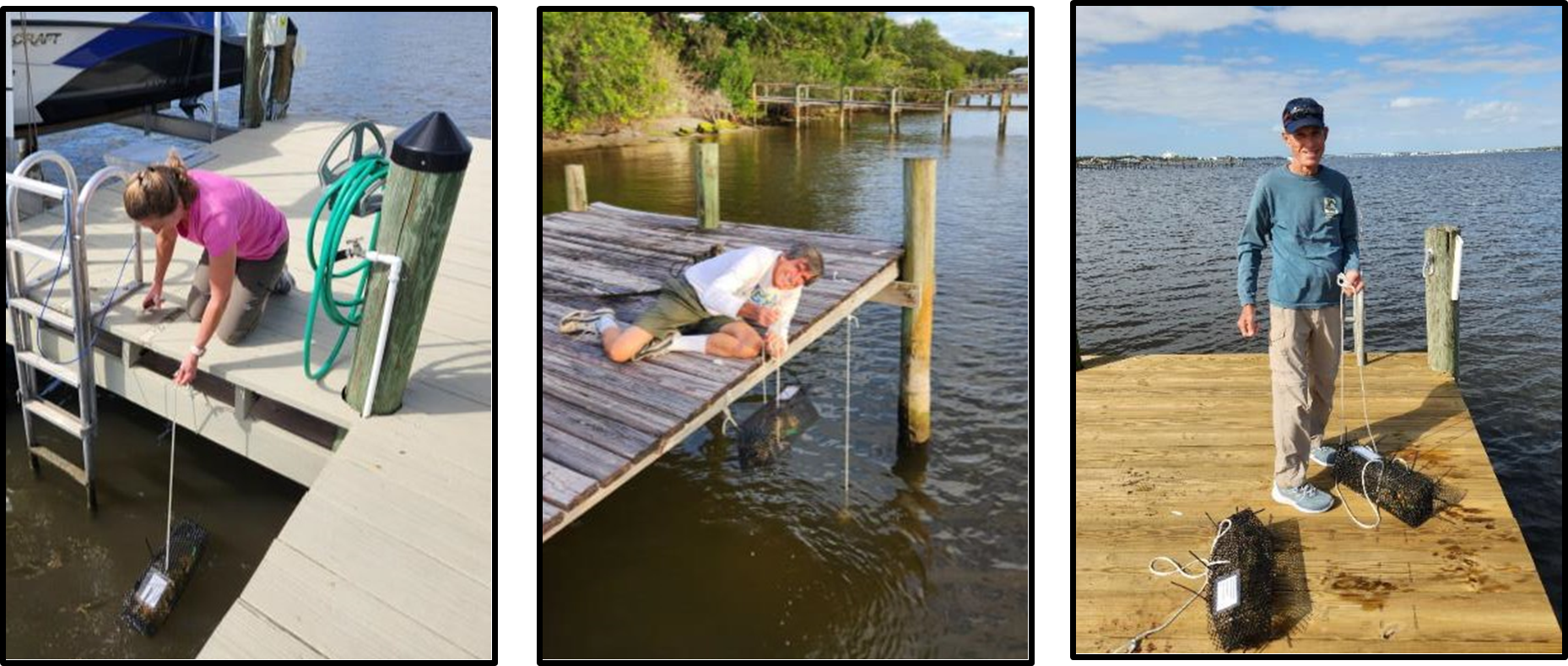
Figure 4. Our Oyster gardeners all hard at work caring for their oysters! From left to right: Lisa Peery, Marc Teplitz, and Phil Dakin.
Literature Cited
Lapointe, B. E., Herren, L. W., Debortoli, D. D., & Vogel, M. A. (2015). Evidence of sewage-driven eutrophication and harmful algal blooms in Florida's Indian River Lagoon. Harmful Algae, 43, 82- 102. Rossi-Snook, K., Ozbay, G., & Marenghi, F. (2010). Oyster (Crassostrea virginica) gardening program for restoration in Delaware’s Inland Bays, USA. Aquaculture International, 18, 61-67. Wilson, C., Scotto, L., Scarpa, J., Volety, A., Laramore, S., & Haunert, D. (2005). Survey of water quality, oyster reproduction and oyster health status in the St. Lucie Estuary. Journal of Shellfish Research, 24(1), 157-165.
If you would like to learn more about the health of our waterways, as well as our research and conservation efforts in the Indian River Lagoon and St. Lucie Estuary, subscribe to our Weekly Water Quality Report HERE.
